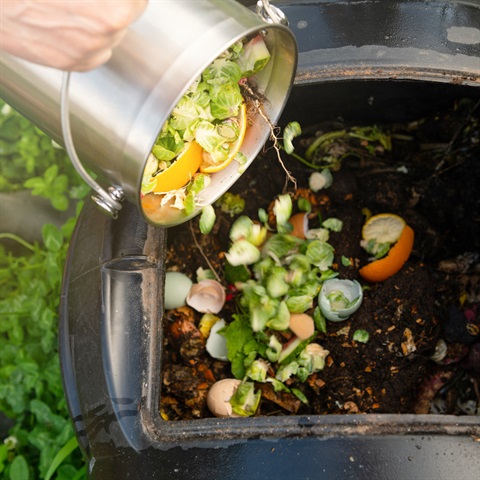Composting Guide

Build Your Own Compost Bin
1. Choosing the site
Composting can be done in a heap, a three-sided brick or timber enclosure, a moulded bin (available from Council's Customer Service Centre) or a rotating barrel, depending upon requirements.
An enclosure promotes rapid decomposition and excellent aeration, while a moulded bin allows easy temperature and vermin control; a barrel is easy to turn over and is portable. The enclosure, barrel, bin or heap should be located in a well-drained, shady position.
2. What to compost
Anything that was once part of a living creature can be composted - however it is generally best to avoid meat, dairy and oily products.
A good tip is to start off with a ratio of 20 parts carbon-rich material, such as dry leaves, sawdust, paper and straw, to 1 part nitrogen rich material such as fruit peelings, tea bags, manure and lawn cuttings.
You may also find it handy to keep a container with a tight fitting lid in your kitchen to collect the compost scraps.
3. Layering
The bottom layer of your compost bin or heap should be comprised of coarse material such as twigs or mulch, about 8 -12 cm thick. This allows air to enter the heap.
You should add a thin layer of food scraps on top of this, followed by a layer of old grass clippings and then a layer of manure, adding water to the heap after each layer. Continue adding layers until the bin is full.
4. Maintenance
To aerate the heap drive a stake or pipe through the centre of the compost a few times or occasionally turn it. This is one of the most important steps to remember in keeping your compost healthy. You must also remember to keep your compost moist, but not wet.
Lack of air and moisture can make your compost smelly!
When the heap is full, lift the bin off and start a new one elsewhere in the garden, using the top third of the original heap.
Troubleshooting
| Problem |
Cause |
Solution |
| Slow Decomposition |
Too dry |
Add water |
| Slow Decomposition |
Lack of nutrients |
Add 250g of a nitrogen-based fertilizer |
| Slow Decomposition |
Low temperatures |
Insulate by covering with hessian or carpet |
| Slow Decomposition |
Material too large |
Shred material before adding |
| Slow Decomposition |
Lack of air |
Turn compost over more regularly or create vertical air-vent |
| Foul Odours |
Too wet |
Add dry material, such as dry leaves |
| Maggots |
Meat and fat |
Remove meat and fat. Cover maggots with lime and turn compost the next day |
| Weed Germination |
Compost is immature |
Allow more time |
| Weed Germination |
Low temperatures |
Place weeds in centre of heap, and insulate better |